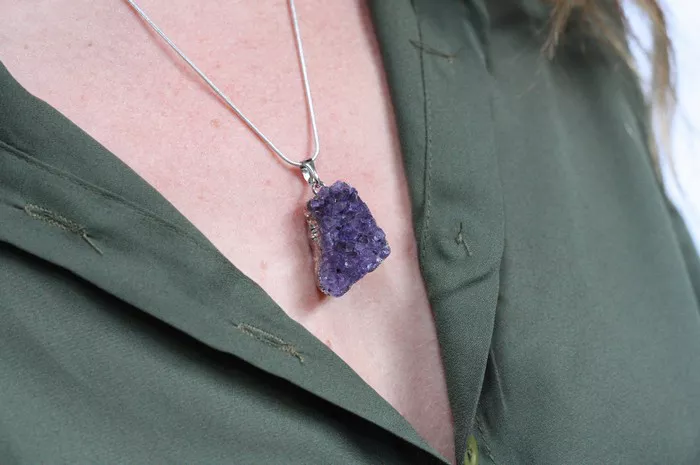Amethyst, with its regal purple hue, has captivated humans for centuries. From ancient civilizations to modern jewelry enthusiasts, this gemstone continues to be highly sought after. However, in today’s market flooded with imitations, discerning the authenticity of an amethyst necklace can be challenging. Fear not, as we delve into the depths of this enchanting gemstone to unveil the secrets of identifying genuine amethyst jewelry.
Understanding Amethyst: Origins and Characteristics
Before embarking on the quest to authenticate your amethyst necklace, it’s crucial to understand the gemstone itself. Amethyst is a variety of quartz, distinguished by its striking purple coloration ranging from pale lavender to deep violet. This gemstone owes its color to trace amounts of iron within its crystal lattice.
Amethyst can be found in various locations around the world, including Brazil, Uruguay, Zambia, and Russia. Its popularity in jewelry stems not only from its captivating color but also from its relative abundance and affordability compared to other gemstones.
When examining an amethyst necklace, it’s essential to consider certain characteristics that distinguish genuine amethyst from its synthetic or simulated counterparts. These characteristics include color, clarity, hardness, and natural variations.
Assessing Color: The Hallmark of Authentic Amethyst
The color of amethyst serves as one of the primary indicators of its authenticity. Genuine amethyst exhibits a range of purple hues, from delicate lilac to rich violet, with even saturation throughout the gemstone. Natural amethyst often displays slight color zoning, where different areas of the stone may exhibit varying intensities of purple.
Imitations, such as glass or synthetic quartz, may lack the nuanced color variations found in authentic amethyst. Glass imitations tend to have a uniform and artificial appearance, lacking the depth and complexity of genuine gemstones. Synthetic quartz, while possessing a similar chemical composition to natural amethyst, may exhibit overly saturated or unnaturally vibrant colors.
When assessing the color of an amethyst necklace, examine it under various lighting conditions, including natural sunlight and artificial light sources. Authentic amethyst will maintain its distinctive coloration across different lighting environments, whereas imitations may appear dull or inconsistent.
Delving into Clarity: Natural Inclusions and Flaws
Like all gemstones, amethyst possesses inherent characteristics that contribute to its uniqueness. Natural inclusions, such as mineral deposits and internal fractures, are common in authentic amethyst and can help distinguish it from synthetic alternatives. These inclusions are often visible under magnification and lend character to the gemstone.
Synthetic amethyst and glass imitations typically lack the natural imperfections found in genuine gemstones. Upon close inspection, synthetic varieties may appear flawless and devoid of any internal features characteristic of natural amethyst.
However, it’s important to note that not all inclusions are indicative of authenticity. Some treatments, such as heat or irradiation, can alter the appearance of amethyst and mask certain imperfections. Therefore, while clarity can provide valuable insights, it should be considered alongside other factors when assessing amethyst authenticity.
Testing Hardness: A Tale of Resilience
Another method of verifying the authenticity of an amethyst necklace is by testing its hardness. Amethyst, like all quartz varieties, has a Mohs hardness rating of 7, making it relatively durable and resistant to scratching. This property allows genuine amethyst to withstand everyday wear and tear without sustaining significant damage.
To test the hardness of an amethyst necklace, gently attempt to scratch the surface using a harder material, such as a steel nail or a piece of quartz. Authentic amethyst should remain unscathed, displaying minimal to no signs of scratching.
In contrast, imitations made from glass or synthetic materials may exhibit scratches or abrasions when subjected to the same test. Glass imitations, in particular, are susceptible to scratching due to their lower hardness compared to natural quartz.
Embracing Natural Variations: The Beauty of Imperfection
One of the hallmarks of authentic gemstones is their inherent variability and uniqueness. Natural amethyst exhibits a range of characteristics, including variations in color, clarity, and texture, that contribute to its individuality.
When assessing the authenticity of an amethyst necklace, embrace the natural variations inherent to the gemstone. Genuine amethyst may display subtle differences in color saturation, distribution of inclusions, and overall appearance from one specimen to another.
Imitations, on the other hand, often lack the organic nuances found in natural gemstones. Mass-produced synthetic or simulated amethyst necklaces may appear uniform and standardized, devoid of the quirks and imperfections that make each genuine gemstone truly one-of-a-kind.
Seeking Professional Evaluation: Expert Guidance
In cases where uncertainty persists or when dealing with high-value amethyst jewelry, seeking professional evaluation from a qualified gemologist is advisable. Gemologists possess the expertise and specialized tools necessary to accurately assess the authenticity and quality of gemstones, including amethyst.
A professional evaluation may involve comprehensive testing techniques, such as spectroscopy and microscopy, to analyze the chemical composition and structural characteristics of the gemstone. Additionally, gemologists can provide valuable insights into the provenance and authenticity of amethyst jewelry, helping buyers make informed decisions.
When consulting a gemologist, ensure they are accredited by reputable organizations, such as the Gemological Institute of America (GIA) or the International Gemological Institute (IGI). These certifications serve as a testament to the gemologist’s expertise and adherence to industry standards.
Conclusion
In the realm of gemstones, authenticity reigns supreme. When it comes to amethyst necklaces, discerning genuine gemstones from imitations requires a keen eye and a thorough understanding of the gemstone’s characteristics.
By examining factors such as color, clarity, hardness, and natural variations, enthusiasts can unravel the mysteries of amethyst authenticity. Whether admiring the rich purple hues of a natural gemstone or seeking expert guidance from a certified gemologist, the journey to discovering authentic amethyst jewelry is as enchanting as the gemstone itself.
So, the next time you find yourself captivated by the allure of an amethyst necklace, remember to look beyond its outward appearance and delve into the depths of its authenticity. For within the heart of every genuine amethyst lies a story waiting to be told—a story of beauty, resilience, and timeless elegance.

